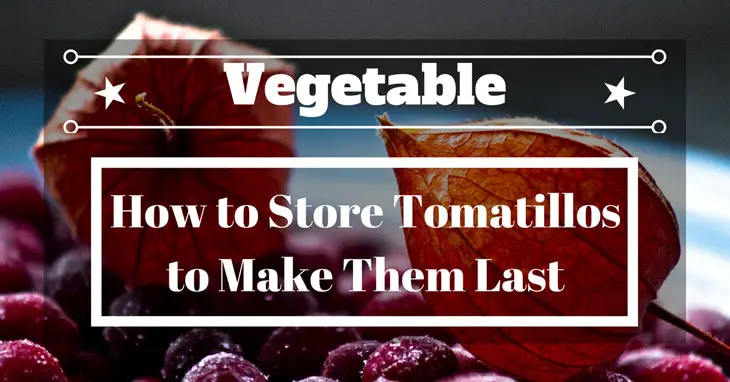How to Store Tomatillos to Make Them Last
Husk tomato or more popularly known as tomatillo is a cousin of tomato that is popularly used in Mexican and Central American sauces. It is unique in appearance in that it comes with a papery shell that splits open as the fruit matures and ripens. Tomatillo is a seasonal fruit as they are only abundant in the summer and early fall. The good thing is, you can make them last with proper storing techniques.
More...
Before discussing how to store tomatillos, it would be good to have some background about this fruit.
What is a Tomatillo?
There are different colors of tomatillo fruits depending on its cultivar. The green and yellow ripening cultivars have a tart flavor and lemony scent and is commonly used in green sauces. On the other hand, the red and purple ripening cultivars are great for jams and preserves because of their slight sweetness. While tomatillos are generally less juicy than the regular tomatoes, they have a richer and more pronounced flavor.
Moreover, tomatillos are high is pectin, which is a thickening or gelling agent that is used as a stabilizer in foods. Popular varieties include Purple de Milpa, Dr. Wychs Yellow, Green Husk Tomatillo, Purple Tomatillo and Toma Verde.
Harvesting Tomatillos
If you are looking to store tomatillos, it is important to have the right kind of fruits. And to achieve that, you need to harvest them at the right time
Tomatillos mature to the size of cherry tomatoes. The smaller fruits are more often sweeter than the larger ones. From day 1 of sowing, you can expect to harvest them after about 75 to 100 days. One plant can bear 60 to 200 fruits in one seasons, with proper fertilization and care.
When harvesting the fruits, you can use garden pruners to cut them from the branch. Make sure to just remove those fruits that have already started to expand out of their husks. Check the bottom of the fruit if it is opening because of its size. It is a sign that the fruit is already ripe.
The best tomatillos to store are those that have a smooth and firm skin and are tightly attached to their husks. With proper storage, tomatillos can last up to 10 months.
How to Store Tomatillos
There are two options for storing tomatillos. Choosing one over the other method depends on when you need them. Also, you can store the fruits with or without the husks. If you choose to remove the husks, one good trick is to soak the fruits first in a bowl of warm water for about 10 minutes. This will soften the husks, allowing you to remove them easily.
Short Term Storage
- Option 1
- Option 2
Option 1 (could last up to 2 months)
1. After harvest, keep the tomatillos in their husks.
2. Put the tomatillos in a hanging basket and in a cool dry and ventilated area like in your pantry.
Long Term Storage
- Option 1
- Option 2
- Option 3
If you want to prepare tomatillo salsa, I found this perfect recipe from Genius Kitchen.
You will need the following ingredients to make this salsa:
6 cups of chopped tomatillos
3 cups of chopped onions
3 pcs of jalapeno peppers, finely chopped
6 cloves of garlic, finely chopped
1⁄2 cup of cilantro, finely chopped
1⁄2 cup of lemon juice
2 teaspoons of cumin
1 tablespoon of salt
1 teaspoon of black pepper
Procedure:
If you are not yet familiar with doing hot water baths, the Spruce has a step-by-step procedure that you can follow. I only included here the steps for the water bath before filling in the jar and after filling in the jar.
Basic Equipment
Water bath before filling in the jar
1. Place the rack at the bottom of the pot and then place the jar on top of it. Arrange the jars properly to prevent them from rattling against each other which can cause breakage. Add water, enough to cover at least one inch above the lids.
2. Turn on the heater. If you are raw-packing, heat the water up to 140 degrees. If hot-packing, bring the water to boil at 180 degrees.
Note: the lids should be new while the rings can be reused. Follow the jar manufacturer’s instructions with regards to heating the jar and lid together or on a separate water bath.
After filling in the jar with the salsa, you can then follow this procedure:
1. Place the rack again in the pot and then arrange the jars vertically. The water should be at least one inch above the top of the jars. Make sure to also leave at least ½ inch in between jars.
2. Turn the heat on and bring the water to a boil. Place the lid on the pot.
3. Once the water boils, this is when you start timing the water bath. According to the canning recipe above, keep the jars in a water bath for 20 minutes.
4. When the processing time is done, turn off the stove and leave the jars for 5 minutes.
5. Remove the jars from the rack and let them cool. Make sure to leave the jars undisturbed for about 12 to 14 hours.
Conclusion
Storing tomatillos is a straightforward and easy process. You can also choose from any of the storing options we have listed above. Tomatillos are a versatile fruit and you can use them in a variety of dishes. If you have them in your garden and you have more than enough that you can use, why not store them?
References:
https://www.leekgarden.com/how-to-store-tomatillos/
https://gardenambition.com/how-to-store-tomatillos/
https://www.thespruce.com/guide-to-water-bath-canning-1327461
http://www.vegetablegardenplanner.com/how-to-store/tomatillo
Do you also love tomatillos? Do you have any other way of storing them? Please share with us your technique through the comment section. Also, don’t forget to share this article with your friends.

